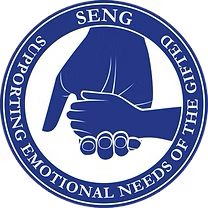Meet David and Anna. David is a seventh grade student attending an urban middle school with a strong equity orientation and a high percentage of students from low-income families. Thirty minutes away in the suburbs, Anna attends a private school where many parents are in the top five percent of income earners. Both David and Anna are gifted and have a history of trauma. Anna has been diagnosed with anxiety and depression as a result of severe social bullying. David’s teachers and parents are working in partnership with mental health providers to better understand his strengths and needs. The signs of injury in David and Anna look different: David frequently fights in response to trauma; Anna tends to respond by freezing and hiding her sadness. When concerns were reported, schools sometimes failed to explore issues in depth from multiple perspectives, inadvertently contributing to continued suffering. The staff at both schools have the best intentions, but supporting healing and learning in school environments can be particularly complex.
Given the dearth of research on trauma in gifted youth, parents and educators often feel uncertain about how best to support students; adults may be unaware that trauma is the root cause of challenging behaviors. Trauma occurs when an individual’s brain becomes stuck in survival mode (Walker, 2013). This article provides a brief introduction to signs of trauma and strategies to support healing while partnering with mental health care professionals.
Why Understanding Trauma Matters
High emotional development, advanced cognition and strong mental health may strengthen resilience, but they do not immunize individuals from trauma. Anyone can experience psychological injuries from violence, abuse and/or neglect. Unbearable feelings can result in extreme coping behaviors.
Bullying behavior can cause injuries, including trauma in some cases. Jean Peterson’s research reveals two-thirds of gifted students have experienced bullying by eighth grade (2006), more than double the incidence in the overall population (StopBullying.gov, 2016). The more gifted a student is, the greater the likelihood they will experience bullying. Ending the cycle of violence requires educators and parents to work together to improve understanding and responses.
An Overview
The National Institute of Mental Health notes trauma can occur independent of physical injury and may provoke immediate or delayed reactions (2013). Trauma may result from assault, violence, or subtle chronic neglect or oppression. High cortisol production associated with trauma or chronic stress can damage neurons in critical brain regions and lead to dissociation or hyperarousal (Center for Non-violence and Social Justice, 2016). Youth who have experienced trauma often show elevated heart rates even when appearing calm (Devereux, 2016).
In the American Psychological Association, Tori DeAngelis explains that youth affected by complex trauma often receive diagnoses that inadequately describe their needs, including pervasive developmental disorders, oppositional defiant or conduct disorder, reactive attachment disorder, affective disorders, anxiety disorders, and PTSD. Symptoms of developmental trauma can include anxiety and depressed mood; distrust and conflict in relationships; distorted beliefs about people and the world; feelings of anger, sadness, guilt, fear and shame; dissociation, negative self-beliefs, and avoidance (DeAngelis, 2007). Intense shame and guilt can interfere with seeking and receiving support (Firestone, 2010).
Importantly, Devereux differentiates forms of trauma: complex trauma (exposure to chronic trauma perpetrated by people in positions of power) contrasted with acute trauma (a single traumatic event) and chronic trauma (multiple traumatic events) (Devereux, 2016). Firestone adds that complex trauma is often repetitive, exploitative, and occurs during times of particular vulnerability (2010).
Symptoms and effects vary in intensity and duration. The ACE study found adverse childhood experiences occur more frequently than predicted and that higher ACE scores correlate with numerous long-term health and social problems, including disabilities, substance abuse, relationship instability, suicide risk, and increased incidences of heart, lung, and liver disease (Devereux, 2016).
Signs of Trauma May Include:
- Hyper-arousal and/or hyper-vigilance
- Irritable, aggressive and/or disruptive behavior
- Shaking or trembling
- Regressive behavior
- Drop in grades or performance
- Loss of interest in previously enjoyed activities
- Confusion and lack of attention to details
- Suicidal thoughts
- Variety of physical ailments and illnesses
- Feelings of fear and anxiety
- Sleep disturbance
- Difficulty concentrating
- Self-destructive or reckless behavior
- Nightmares and/or flashbacks
- Headaches
- Depression
- Guilt and/or self-blame
- Feeling emotionally numb
- Organizational challenges
- Elevated blood pressure
- Distorted self-concept
- Challenges in mood regulation
- Increased resting heart rate
- Emotional breakdowns
- Eating disorders
- Truancy / high absenteeism
- Social isolation
The Impact of Trauma on Identification & Programming
The impact of trauma on physical and emotional health underscores the need for early identification practices and strong parent–educator partnerships. Schools and families both need information from each other to inform decisions. If an individual exhibits behaviors or signs associated with trauma, meet them with compassion; stigma may make students and families reluctant to share traumatic experiences.
Until adequate healing occurs, caregivers may not have an accurate approximation of a student’s abilities. Educators can reduce unnecessary exposure to triggers and consider substituting content that may re-traumatize or cause regression during the healing process.
Learning Environment Considerations:
Spaces mindful of sensory sensitivities support youth healing from trauma and also sensitive gifted learners. Attention to environmental elements can make the classroom less taxing on a student’s nervous system: remove fluorescent lights, use natural lighting, keep volume levels low, avoid harsh cleaning chemicals, reduce upsetting auditory and visual stimulation, and decorate with soothing colors and images.
- Prepare or signal students for changes, transitions, or surprises using calm, soft tone and rehearsal when possible
- Avoid unnecessary exposure to upsetting stimuli
- Identify patterns that result in student shutdown
- Use non-verbal cues to signal when a student may be starting to shut down
- Identify staff the student feels safe discussing traumatic events with and create a procedure for accessing those staff
- Provide an appropriate fidget item
- Teach and practice calming techniques and emotional literacy skills
- Provide opportunities for alternate modes of expression, including art and music
- Support students in creating a Calming Toolbox (puzzles, art supplies, yoga poses, guided meditations, tea, mindfulness practices, inspirational quotes, etc.)
- Encourage students to take breaks and ask for help as needed
- Celebrate mistakes
- Include the student in decision-making and encourage independent progress tracking
- Practice unconditional positive regard
Collaborate with relevant mental health care professionals throughout.
A Closing Note
Grieving is typical after trauma; even without actual loss, survivors must cope with the loss of safety and security (HelpGuide, 2016). It remains unclear how giftedness affects healing; future research is needed. Meanwhile, the SENG community is invited to share resources and helpful strategies.
References and Resources
Center for Nonviolence and Social Justice Website. (2016). What is Trauma? [website]. Retrieved from: http://www.nonviolenceandsocialjustice.org/FAQs/What-is-Trauma/41/
DeAngelis, T. (2007). Current Trauma Diagnoses. American Psychological Association. Retrieved from: http://www.apa.org/monitor/mar07/trauma.aspx
Devereux Colorado. (2016). Trauma-Informed Care: A Developmentally Sensitive Approach. (Lecture).
Firestone, L. (2012). Recognizing Complex Trauma. Psychology Today. Retrieved from: https://www.psychologytoday.com/blog/compassion-matters/201207/recognizing-complex-trauma
HelpGuide. (2016). Emotional and Psychological Trauma: Symptoms, Treatment and Recovery. Retrieved from: http://www.helpguide.org/articles/ptsd-trauma/emotional-and-psychological-trauma.htm
National Child Traumatic Stress Network. Retrieved from: http://nctsn.org/trauma-types/early-childhood-trauma/Symptoms-and-Behaviors-Associated-with-Exposure-to-Trauma
National Institute of Mental Health. (2013). Helping Children and Adolescents Cope with Violence and Disasters. Retrieved from: http://www.nimh.nih.gov/health/publications/helping-children-and-adolescents-cope-with-violence-and-disasters-parents-trifold/file_146810.pdf
Peters, D. (2012). Gifted and Bullied. Retrieved from: http://summitcenter.us/wp-content/uploads/2012/07/GiftedandBullied_GEC_Spr2012.pdf
Peterson, J. (2006). Gifted Children Especially Vulnerable to Effects of Bullying. Retrieved from: http://www.purdue.edu/uns/html4ever/2006/060406.Peterson.bullies.html
Stop Bullying Website. (2016). Retrieved from: http://www.stopbullying.gov/news/media/facts/index.html#listing
Walker, P. (2013). Complex PTSD: From Surviving to Thriving. Settle: Create Space Independent Publishing Platform.

